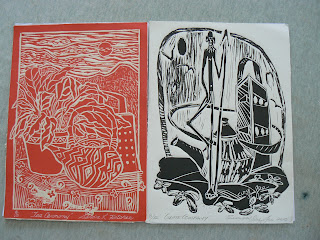For as long as I am prepared to continue printing in this manner I will always collect number 8 and should I decide not to participate each year then my number goes to someone else. As we break for two months over the Christmas period it is good to have something to work on and to keep the hand in.
Our first swap , year 2009.
Printbank Mackay Inc. first swap collection and edition of ten. Portraits was the chosen subject and I eagerly awaited for my collection and it is interesting to see so many different styles and mark marking.
YEAR 2010
First bundle for year 2010
My subject choice was voted in this year so I decided to present them with a challenge of sorts. Naturally the size was to be adhered to but colour's and medium were a free choice of the printer.
To help create interest I limited them to three objects from the kitchen only with my choosing one item that was to be included somewhere with the other two as their own choice. My choice was a grater as I like the shape and every possibility of texture could be applied. I have photographed these in three bundles due to more participating.
Bundle two and it is nice to see plenty of colour.
The final two for this year.
YEAR 2011
First bundle.
This year tree trunks was the voted subject and once again great one for texture. So many different shapes to trees as well.
Final few for trees. I like the colours , shapes and the embossing on some is a nice touch.
And for year 2012 we are all working on a tribute to Margaret Olley. More on that later.















